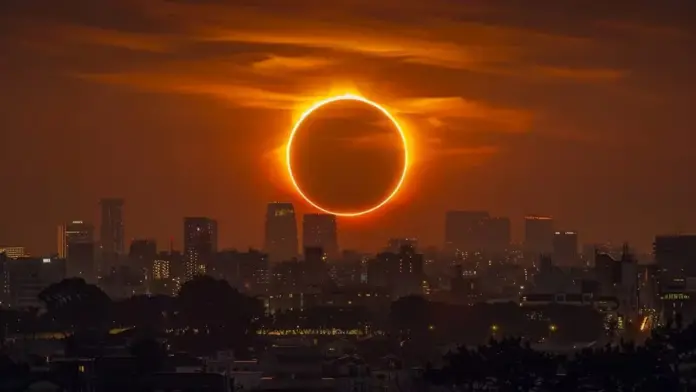:quality(85)/cloudfront-us-east-1.images.arcpublishing.com/infobae/V2QQ5KP6BVERXPCLOD25JZYFFQ.jpg)
An annular solar eclipse, like the one that will occur on October 2, occurs when the Moon is at its apogee, the furthest point from the Earth in its orbit, and passes between the Earth and the Sun. Due to the distance, the Moon does not completely cover the surface of the Sun, leaving a ring of sunlight visible around the Moon.
This phenomenon is known as the “ring of fire” and during the eclipse it is observable from certain specific areas of the Earth.
And while the best countries in the world to see it are Argentina and Chile, in our country it is also within the shadow band created by the stars, so it will be perceived although in a limited way.
What time does the eclipse begin in the cities where the eclipse will be visible
In Mexico, the eclipse will be partially visible in certain states. The regions where this astronomical event can be best observed are Baja California, Baja California Sur, Colima and Jalisco in the cities of La Paz, Los Cabos, San José del Cabo and Manzanillo.
Here we tell you the exact time at which the event will begin in the different cities where it can be seen.
Cabo San Lucas:
Start time: 9:48
Maximum point: 10:11
End time: 10:36
San José del Cabo
Start time: 9:51
Maximum point: 10:11
End time: 10:32
La Paz
Start time: 9:56
Maximum point: 10:10
End time: 10:23
Manzanillo
Start time: 11:17
Maximum point: 11:24
End time: 11:30
It is worth mentioning that, according to the Time And Date portal, specialized in climate and astronomical events, the event will also be largely observable in Brazil, Bolivia, Paraguay, Peru, Ecuador and Uruguay, as well as in the Falkland Islands.
Tips to appreciate the eclipse
Check the weather and make sure to look for a place with a clear sky, otherwise it will be even more difficult to appreciate it
If you have a telescope, don’t hesitate to use it since in Mexico it will be partially visible, you might need a little extra help.
If you want to appreciate it with the naked eye, despite its low visibility in the country, don’t forget to always protect your eyesight by using special glasses or the well-known No. 14 welder’s filter.
It is important to mention that in Mexico the visibility percentage will be very low so you may only notice subtle changes in the moon or in the intensity of the sun
As we mentioned before, the countries that will be able to appreciate it best are Chile and Argentina while in Mexico it is estimated that visibility will be only 11%.
Despite this low percentage, it is always possible to observe the phenomenon in an online broadcast or, as we mentioned, take advantage of having a specialized device such as a telescope.
These are other astronomical phenomena that can be seen in Mexico before the end of the year
October 18: Partial solar eclipse. This eclipse will be seen as partial in several parts of Mexico. Although it will not be as spectacular as the total eclipse in April, it is still a notable event.
November 17-18: Leonid Meteor Shower. Although not as prolific as other meteor showers, the Leonids are known for producing bright and spectacular meteors.
December 13-14: Geminid Meteor Shower. Considered one of the best meteor showers of the year, the Geminids can produce up to 120 meteors per hour at their peak under optimal conditions.
Source: infobae






